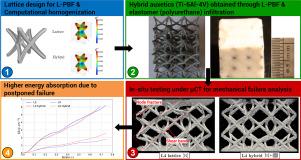混合auxetics:用Ti-6Al-4V晶格的弹性体渗透延缓失效
IF 9.4
1区 工程技术
Q1 ENGINEERING, MECHANICAL
International Journal of Mechanical Sciences
Pub Date : 2025-09-08
DOI:10.1016/j.ijmecsci.2025.110704
引用次数: 0
摘要
这项工作研究了如何使用软弹性相来增强和延缓增材制造的金属晶格结构的失效。为了保证Ti-6Al-4V激光粉末床熔接的可打印性,设计了一种新型的六边形熔池。一旦被柔性聚氨酯渗透,这些混合晶格在支柱级破坏和剪切带形成方面表现出明显的延迟。微层析成像结合原位压缩实验证实,聚合物相减轻了未填充晶格中常见的节点开裂。虽然混合晶格仅在大变形时表现出相当或略有增加的刚度,但其增强的完整性和应力重新分配表明,它们有望用于需要高延展性或能量吸收的耐撞性和冲击应用。我们讨论了填料和金属骨架之间的刚度比如何决定改进的程度,为下一代混合晶格提供了设计指南。这是第一个原位层析证据,证明柔顺矩阵可以推迟增材制造金属补充晶格的临界剪切带。本文章由计算机程序翻译,如有差异,请以英文原文为准。

Hybrid auxetics: Postponing failure with elastomer infiltration of Ti-6Al-4V lattices
This work examines how a soft elastomeric phase can be used to reinforce and delay the failure of additively manufactured metal lattice structures with auxetic geometry. A novel hexaround unit-cell was designed to ensure printability of Ti-6Al-4V via laser powder-bed fusion. Once infiltrated with a compliant polyurethane, these hybrid lattices showed a pronounced delay in strut-level failure and shear-band formation. Microtomography coupled with in-situ compression experiments confirmed that nodal cracking commonly observed in unfilled lattices is mitigated by the polymer phase. While hybrid lattices exhibited comparable or slightly increased stiffness only at large deformations, their enhanced integrity and stress redistribution suggest promise for crashworthiness and impact applications requiring high ductility or energy absorption. We discuss how the stiffness ratio between filler and metallic skeleton determines the extent of improvement, offering design guidelines for next-generation hybrid lattices. This is the first in-situ tomographic evidence that a compliant matrix can defer the critical shear-band in an additively manufactured metal auxetic lattice.
求助全文
通过发布文献求助,成功后即可免费获取论文全文。
去求助
来源期刊

International Journal of Mechanical Sciences
工程技术-工程:机械
CiteScore
12.80
自引率
17.80%
发文量
769
审稿时长
19 days
期刊介绍:
The International Journal of Mechanical Sciences (IJMS) serves as a global platform for the publication and dissemination of original research that contributes to a deeper scientific understanding of the fundamental disciplines within mechanical, civil, and material engineering.
The primary focus of IJMS is to showcase innovative and ground-breaking work that utilizes analytical and computational modeling techniques, such as Finite Element Method (FEM), Boundary Element Method (BEM), and mesh-free methods, among others. These modeling methods are applied to diverse fields including rigid-body mechanics (e.g., dynamics, vibration, stability), structural mechanics, metal forming, advanced materials (e.g., metals, composites, cellular, smart) behavior and applications, impact mechanics, strain localization, and other nonlinear effects (e.g., large deflections, plasticity, fracture).
Additionally, IJMS covers the realms of fluid mechanics (both external and internal flows), tribology, thermodynamics, and materials processing. These subjects collectively form the core of the journal's content.
In summary, IJMS provides a prestigious platform for researchers to present their original contributions, shedding light on analytical and computational modeling methods in various areas of mechanical engineering, as well as exploring the behavior and application of advanced materials, fluid mechanics, thermodynamics, and materials processing.
 求助内容:
求助内容: 应助结果提醒方式:
应助结果提醒方式:


